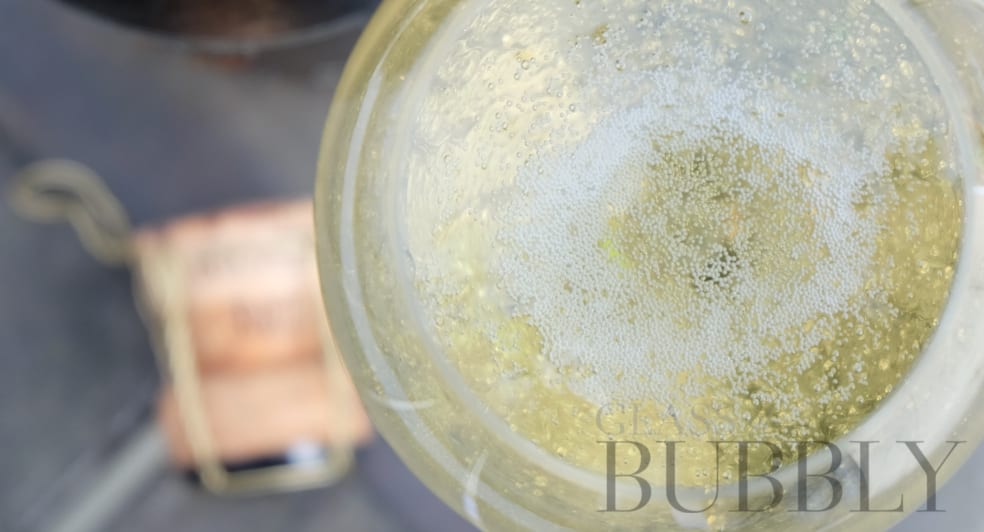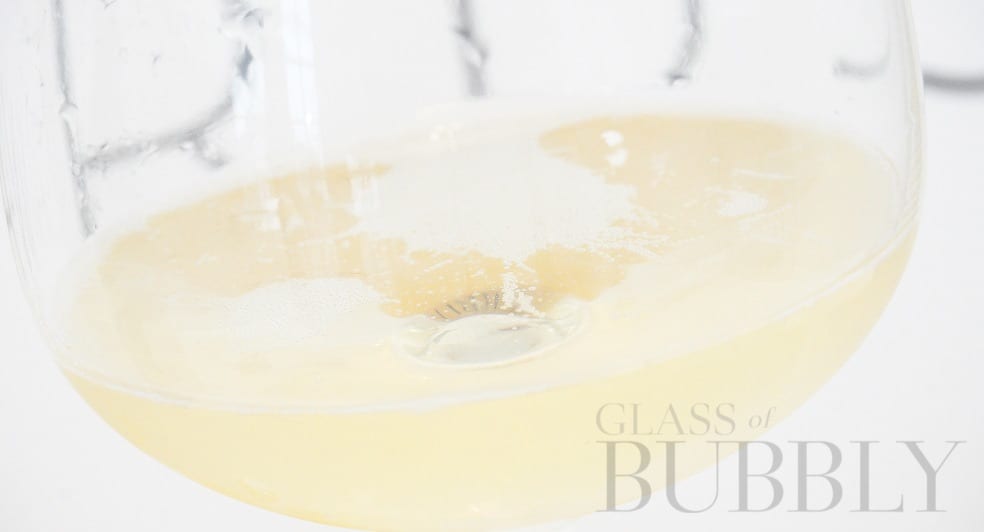How Important Are The Size Of Bubbles To Winemakers?
9th June 2022

When You Look Into A Glass of Bubbly, What Do You See?
Do you see the universe displayed before you, do you see the stars and galaxies, do you see music, friends, love or do you see the craftsmen ship of the winemaker?
Any glass of Sparkling Wine has bubbles, big bubbles, medium bubbles or small bubbles, with the smaller bubbles normally indicating better quality, but is there something more to see? Winemakers spend many years of their lives perfecting the colours, aromas and flavours of their Sparkling Wines, but one thing we don’t speak about much is the bubbles and I’m not just talking about the size of them.
How Are Sparkling Wine Bubbles Made?

To first understand if the bubbles tell a story, we need to understand how Sparkling Wine bubbles are made, we need to go through the fermentation process.
The First Fermentation turns the sugar in the grape juice into wine, it alcoholises the juice.
The Second Fermentation is where the bubbles come in, they add yeast and sugar to the juice, the yeast will then start consuming the sugar, which creates carbon dioxide and also increases the alcohol content.
If we look at one of the most famous Sparkling Wines, Champagne, the Second Fermentation takes place in the bottle, after the yeast and sugar have been added, the fermentation process lasts just 2 months, increasing the alcohol content and building the carbonic pressure inside the bottle, creating the bubbles.
After the yeast has finished eating the sugar, the yeast will die and start to break down, into smaller and smaller pieces. Yeast can stay in the bottle for up to 30 years, to put it simply, the longer you leave the yeast in the bottle the finner the bubbles will be and generally speaking, the better quality of Champagne you will get.
Let me just clear something up, you can leave the yeast in the bottle until the end of time, Champagne could last forever, but the bubbles will eventually start to disappear, I once enjoyed a bottle of Champagne from the vintage year 1966 (the same year England won the World Cup) and it remains one of the best Champagne’s I’ve ever tasted, despite it having no bubbles.
In that example, all the CO2 had dissolved, slowly over the years escaping through the cork.
How Important Are The Size Of Bubbles To Winemakers?
The only way to answer this question was to reach out to some well-known Winemakers and ask them directly. I asked 4 Winemakers from 4 different countries, including Champagne and Prosecco.
I’ll start with Prosecco, reaching out to Villa Sandi’s Head Winemaker Stefano Gava, then heading over to Champagne to Laurent Lequart the same question, I then went across to Slovenia, asking a very skilled Sparkling Wine producer called Igor Tiefengraber and finishing off in my home country of England, I ask Sam Lindo the head Winemaker for Camel Valley his views on the size of bubbles.

Stefano Gava – Head Winemaker at Villa Sandi
“The importance of having bubbles with a medium-small diameter is essential to obtain a product with organoleptic characteristics of absolute value. A small bubble determines a fine and elegant perlage almost velvety in the mouth.”

Laurent Lequart – Owner and Winemaker at Champagne Laurent Lequart
“I attach great importance to the quality of the wines as well as to the effervescence of my wines. The attention paid to the vinification and the conservation of the wines will have an action on the finesse of the bubbles.
“But before judging a wine on the delicacy of the bubbles and its effervescence, it is already necessary to take care to know the course of the vinification and the age of this cuvée. A rich cuvée with a lot of fat and prolonged aging will have less abundant effervescence and less airy bubbles.”
 Igor Tiefengraber – Owner and Sparkling Wine Producer at Evana Tiefengraber
Igor Tiefengraber – Owner and Sparkling Wine Producer at Evana Tiefengraber
“I never considered myself a wine maker but a sparkling wine producer because I decided to do only top quality sparkling wines 30 years ago when I finished my post graduate enology studies at UCI Davis.
“Of course, it must be said that sparkling wines were not nearly as attractive then as they are today. Especially those, which were like mine, that were made without the use of oenological aids, without the use of sulphur and produced in a sustainable way. Namely, I have always relied solely on knowledge and scientific approach in the winemaking process.”
“Since then I have been fascinated by watching the bubbles in the bottle, like a fisherman looking at his bait for days and days.”
“Bubbles are an essential element of sparkling wine, which is why we call them so. Sparkling wine without bubbles is just a wine.”

Sam Lindo – Head Winemaker at Camel Valley
“Yes, bubbles and foam quality are important to the perception of wine quality. From a winemaking point of view, I don’t worry about it too much. The glass the wine is served in can kill all the effort in a flash.”
Do Smaller Bubbles Mean A Finer Quality of Sparkling Wine?

You will quite often see small bubbles on the likes of vintage Champagne or Traditional Method Sparkling Wines, but this is nowhere near exclusively the case, even the likes of Charmat/Tank Method Sparkling Wines, like Prosecco, can achieve very small and elegant bubbles.
If you hear someone say Sparkling Wine has very ‘fine’ bubbles, they are saying that the Sparkling Wine has small bubbles.
Do you agree with the statement that ‘smaller bubbles mean a finer quality sparkling wine’?
“I fully agree with this statement.” – Stefano Gava
“I agree with you, the size of bubbles mean a finer quality sparkling wine although from time to time the quality of the cut or the glass may be questioned.” – Laurent Lequart
“The size of bubbles is due to proteins in the wines and the absence of things that might have a negative effect on the mousse such as oils. Small bubbles can indicate the wine is made by the traditional method.”
“Historically traditional method sparkling wines that spent more time on the lees developed finer bubbles so it was a sign of extended lees aging. However, in the UK we also get beneficial proteins in the wines as the grapes have a 30-40 day longer hang time and develop more proteins. Therefore we can have small bubbles with young wines.” – Sam Lindo
“In my experience, the size of the bubbles depends mainly on the age of sparkling wine, further on the inner surface of the wine in the bottle (area of micro particles to which CO2 binds), the size and design of the glass and the temperature of the glass and sparkling wine when serving.”
“As the sparkling wine ages, the proportion of dissolved CO2 in the wine increases and the amount of free CO2 in the bottle decreases proportionally. It is a purely physical law. Therefore, older sparkling wines release CO2 heavier and slower, forming smaller bubbles that last a long time. BTW, in our 10+ years old EVANAs we have 95% of dissolved CO2.”
“On the contrary, when opening younger sparkling wines, we see larger bubbles of free, unbond CO2, which blows us in the nose with its freshness. That is why I call this type of sparkling wine ordinary sparkling wines, and the old ones gastronomy sparkling wines.
“Which size of bubbles is more important? For my gastronomic sparkling wine production line definitely long endless vertical chains of fine little bubbles.”
For producers of other types of sparkling wines which stay less time sur lie, or for Charmat production, of course, the criteria regarding the size of the bubbles are quite different.”
Personally, I think the duration of the bubbles is much more important than their size.”
“The rest is mostly ordered by Mother Nature, physical laws cannot be changed, the older the sparkling wine, the smaller its bubbles. This in most cases means that it has a finer quality at the same time.”
“I personally agree with your statement.” – Igor Tiefengraber

Stefano Gava (Left) Oliver Walkey (Right)
Where do all the bubbles go?

Have you ever left a glass of Sparkling Wine out overnight, I’m guessing that not many of you have, why waste good fizz, but if you ever did, you’d notice that when you woke up, all the bubbles were gone, this is because all the CO2 in the glass has escaped.
When opening any bottle of Sparkling Wine, you can immediately lose up to 80% of the CO2 trapped inside the bottle, that’s why you can send corks flying up to 30mph and even end up really bruising or even killing someone, is it very rare to do so, but never point a Cork towards someone, especially with the metal case on.
But you don’t have to lose 80% of the CO2 from the get go, slowly releasing the Cork from the bottle with a whisper, rather than letting it fly with a loud pop will save more of the precious CO2.
At any one time, you could be looking at over 400 bubbles per second in your Glass of Bubbly.
But your glass could be a hindering point to your front-row seat to the dancing bubbles, it depends on the type of glass you have and even the way that glass has been cleaned to how many bubbles you see, sometimes the Sparkling Wine itself doesn’t have a lot of bubbles to show you, but sometimes they’re being suppressed by your glass, the coupe glass is one of the worst for displaying bubbles, if you’re interested in learning more then check out What’s The Best Glass To Serve Champagne In?
![]()
Oliver Walkey
Champagne and Sparkling Wine Writer, Focused on Bringing the Exciting and Fascinating World of Bubbly to You.
